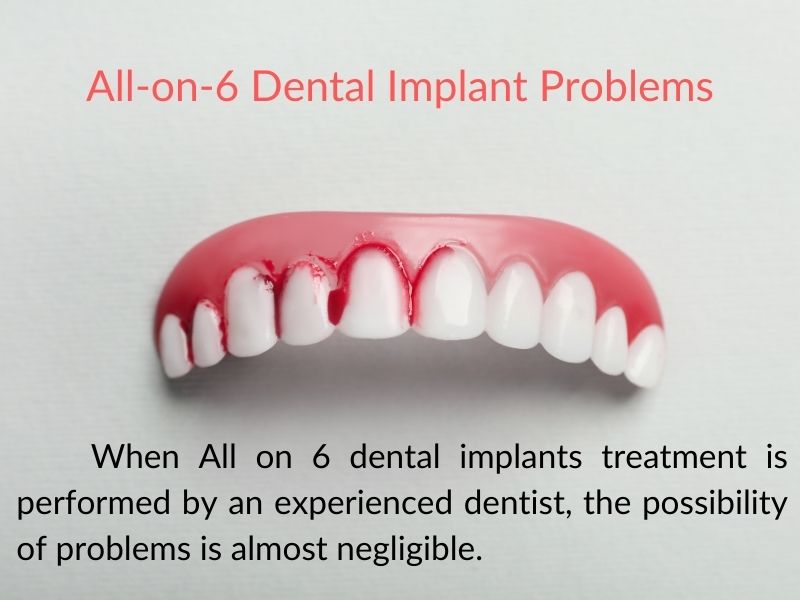
For those who have lost most or all of their teeth, all-on-six dental implants are a common option. During this operation, the jawbone receives six dental implants, each of which supports a complete prosthetic arch. All-on-6 implant success rates are typically high; however, several issues might arise from the procedure's causes and consequences. To guarantee long-term success and pleasure, it is essential that practitioners and patients alike understand these challenges.
Causes of All-on-6 Dental Implant Problems
Poor Bone Quality and Quantity
One of the main reasons why all-on-6 implants don't work is due to insufficient or incorrect types of bone. For security and support, implants need a certain amount of good bone. Implants are less likely to work for people who have lost a lot of bone or have low bone density.
Improper Placement of Implants
Most of the time, the exact location of the all-on-6 implants determines their success. Incorrect implant positioning may cause issues such as misalignment of the prosthetic teeth, insufficient support, and increased stress on certain implants, potentially leading to their failure.
Infection and Poor Oral Hygiene
Implants may fail due to infection around the implant site, commonly referred to as peri-implantitis. Often, this results from insufficient postoperative care or poor dental hygiene. As bacteria gather around the implants, inflammation, bone loss, and finally implant failure occur.
Smoking and Other Lifestyle Factors
Implant failure is far more likely among smokers. Nicotine reduces blood flow to the gums, therefore affecting healing and raising the risk of infection. Other lifestyle choices, such as inadequate food and too much alcohol, may also have an impact on the effectiveness of all-on-6 implants.
Underlying Health Conditions
Illnesses such as diabetes and autoimmune illnesses put patients at a greater risk of experiencing problems with their implants. When these conditions compromise the immune system's capacity to repair and ward off infections, the likelihood of implant failure increases.
Consequences of All-on-6 Dental Implant Problems
Implant Failure and Loss
The most serious outcome of all-on-6 implant issues is the failure and consequent loss of one or more implants. Infection, bone loss, or mechanical implant failure might cause this. Not only can a failing implant compromise the integrity of the prosthetic teeth, but it may also result in further surgical operations to remove and replace the failed implant.
Bone Loss and Jaw Deformities
If an implant fails because of an infection or inadequate implantation, significant bone loss may result. This may cause facial structural alterations and jaw abnormalities over time. Not only does bone loss change the face's look, but it also makes future implant placement challenging.
Gum Recession and Aesthetic Issues
All-on-6 implants might lead to gum recession around their implant site. This compromises the appearance of the prosthetic teeth, which seem unnatural, and exposes the implant posts, raising the risk of further problems.
Functional Problems and Discomfort
All-on-6 implants placed incorrectly or failing may cause functional issues, including pain, trouble eating, and speech impediments. Misaligned implants can cause an uneven bite, which can lead to temporomandibular joint (TMJ) problems and jaw discomfort.
Increased Financial Costs
Correcting issues with all-on-6 implants may be expensive. Additional surgical operations, bone transplants, and replacement implants could significantly increase the therapy's total cost. Patients' need for more regular dental checkups and upkeep may also increase the financial burden.
Preventing All-on-6 Dental Implant Problems
Thorough Pre-Operative Assessment
To find any possible risk factors for implant failure, a thorough pre-operative evaluation is essential. This process involves assessing the patient's general health, lifestyle, and bone quality and quantity. Advanced imaging techniques, such as CBCT (Cone Beam Computed Tomography) scans, allow for precise planning of implant proximity to the patient's jawbone.
Choosing the Right Implant System
Choosing a premium implant system with a track record of effectiveness can help lower the complication risk. (Click for dental implant brands to avoid) The implant's lifetime and stability are greatly dependent on its components and design.
Skilled and Experienced Surgeon
The success of all-on-6 implants depends critically on the dental surgeon's knowledge and expertise. Selecting a surgeon with a background in favourable outcomes and extensive implantology knowledge can greatly reduce the likelihood of issues.
Strict Post-Operative Care and Maintenance
The success of all-on-6 implants depends critically on the dental surgeon's knowledge and expertise. Selecting a surgeon with a background in positive outcomes and extensive implantology knowledge can greatly reduce the likelihood of issues.
Managing Underlying Health Conditions
Patients with underlying medical issues should carefully cooperate with their doctors to properly control their problems. The management of diseases like diabetes will help the body repair itself and lower the chance of implant failure.
Final Assessment
With better function and appearance, all-on-6 dental implants provide a transformative answer for those suffering from extreme tooth loss. However, as with any surgical procedure, there are potential hazards and problems to consider. To ensure the best possible results, patients and professionals must know the reasons behind and effects of these issues. Addressing risk factors, selecting the appropriate implant system and surgeon, and maintaining outstanding post-operative care may raise the probability of successful all-on-6 implants.
Summary:
|
Problem Causes |
Consequences |
Solutions |
|
Poor bone quality and quantity |
Implant failure and loss |
Thorough pre-operative assessment and bone grafting if necessary |
|
Improper placement of implants |
Bone loss and jaw deformities |
Use of advanced imaging techniques and experienced surgeons |
|
Infection and poor oral hygiene |
Gum recession and aesthetic issues |
Strict post-operative care and maintenance of oral hygiene |
|
Smoking and other lifestyle factors |
Functional problems and discomfort |
Cessation of smoking and adoption of a heathier lifestyle |
|
Underlying health conditions |
Increased financial costs |
Management of health conditions in collaboration with healthcare providers |
